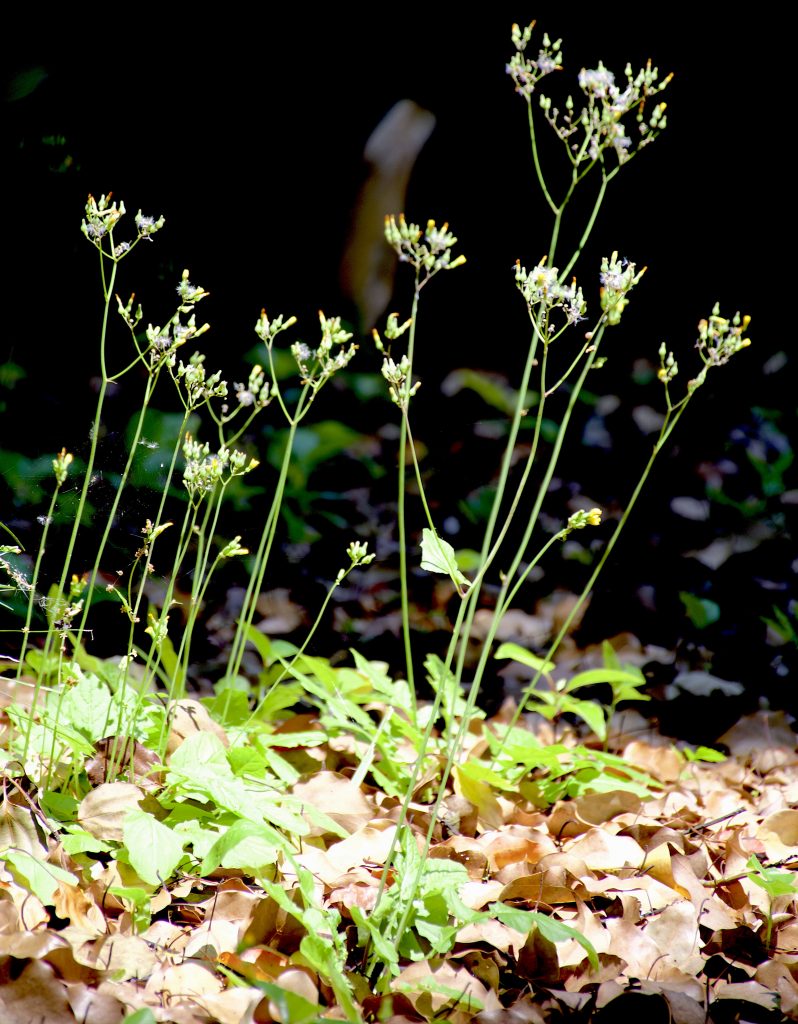
False Hawk’s Beard can have blossoms in all stages. Photo by Green Deane
Crepis Japonica: Seasonal Potherb
If the Crepis fits….wear….ah…eat it
Crepis japonica gets no respect. When I wrote this original article seven years ago you couldn’t find Crepis japonica in field guides on edible plants. And there was very little of substance about it on the Internet other than its name. The same can also be said for its edible cousins, Crepis setosa, Crepis runcinata, Crepis glauca, Crepis capilaris, Crepis bursifolia, Crepis vesicaria and Crepis tectorum. My point, there’s an edible Crepis near you.
All these Crepis have little variations, and some are more or less bitter than the others, but they are found across North America, Europe and Asia. For such an edible group they are barely known. While this article is about the Crepis japonica there is in North America: Crepis capilaris, the Smooth Hawksbeard which is found in most northern states; Crepis glauca or Crepis runcinata, the Fiddle Leaf Hawksbeard which is found along the Rocky Mountains through the United States into Canada; Crepis tectorum, the Narrow Leaf Hawksbeard which is found in the upper half of the United States and Canada; Crepis setosa, the Bristly Hawksbeard, found in a smattering of states of no particular pattern; Crepis vesicaria, the Beaked Hawksbeard, which is found along both coasts of the United States, and Crepis bursifolia, the Italian Hawksbeard, which is found in California, and Europe. Crepis japonica is found from about Pennsylvania south in to the South and west to Texas, also in Asia. What can be said of one, applies to the others and they are used in similar ways.
My local Crepis, C. japonica (KREP-is juh-PAWN-ih-kuh) might not get much attention because they changed its name from”Japanese sandal” which was kind of cute, to ” Japanese Young” or Youngia japonica (YOUNG-ee-ah) honoring which botanist I’ve never been able to find out.) Also being called the Oriental False Hawksbeard doesn’t help. But no matter what you call it, or them, the plants do just fine and are excellent potherbs.
Personally, I prefer the name Crepis japonica than Youngia or hawksbeard. Youngia sounds a bit contrived and I have always associated “hawksbeard” with a totally different plant in a different area of the country.
As for the word “Crepis” we know that Theophrastus, the immediate successor to Aristotle in Athens, mentioned the plant by this name some 2,300 years ago, as did Pliny some 400 years later in Rome. But English-speaking botanists say they don’t know why the genus was named Crepis. They use the phrase “lost to history” to explain that when perhaps they should admit they are linguistically challenged: Knowing a non-speaking, dead form of writing — Latin — doesn’t count towards linguistic proficiency.
Three possibilities are usually offered in English for the word “crepis” (krepis) two of which are not convincing. The first definition is that it describes a step at ancient Greek temples, what we would call a fancy doorstep. I have not been able to confirm “Krepis” ever referred to a temple step, and neither can a Greek professor of Greek I know
A more common ascription is that “krepis” means slipper or sandal, some say boot. Again, research in Greek does not bear that out. But it is getting closer. A secondary use of “krepis” in non-demotic Greek is for the soft leather that makes up the soul of a shoe, back when shoes were more like pointy moccasins. And if you have fantastic eyesight and imagination the seed of the C. japonica might look like a slipper or a sandal. But that is looking very hard for an answer.
The primary use of the word “krepis” in non-demotic Greek was for a textured light cloth that had various uses including veils. From there it went into Dead Latin as “crispus, or, “crisp” meaning curled and wrinkled. Then to French and lastly to English as “crepe” as in “crepe paper.” And indeed the leaves of the C. japonica and the rest, are curled and wrinkled. Crepis explained. You read it here first in 2011 …. lost to history… what nonsense. The more I live the more I think academics are lost inside their ivory towers, or like well frogs: They know only the bottom of their well and the tiny patch of sky above.
The local Crepis, C. japonica, is native to Japan and China and was first mentioned in the United Sates in 1831. It is now found throughout the world, and in many places it grows year round.
There are about 200 Crepis worldwide and a couple of dozen in the United States. At least six are known to make a good potherb if not better than sow thistle and wild lettuce (read my separate articles about Sonchus and Lactuca which is one of several articles I have on wild lettuce.) One writer refers to Crepis as “bitter” but that has not been my experience. In fact, it’s very mild — when picked young and tender. Granted, however, bitterness may vary among species.
As you can see by the photos, it’s a low rosette with a long and skinny flower stock topped by small, dandelion-like yellow flowers, which are rather distinctive. It can blossom, seed and drop old blossoms all at the same time. And, when in seed the Crepis blossom resembles a miniature puffy, slightly ratty dandelion, about one fifth the size.
It might be easy to overlook Crepis in some landscapes but it tends to grow in colonies so you’ll spot a small stand of tall stalks with yellow flowers. It likes grassy areas and does not tolerate mowing well. The roundish dandelion-like leaves are shiny above, soft and dull underneath if not downy. Sometimes some edges of the leaves are decorated with a little dark trim. Veins are pronounced in the leaves, which curl on the edge. “Hawksbeard” also tends to have the same growing season as sow thistle and wild lettuce. Whilst you’re out collecting them keep your eye out for the “Japanese Sandal.”
While C. Japonica can be found as far north as Pennsylvania, it’s more common in the southern United States where it’s considered an invasive weed. But, isn’t that a matter of perspective? It could also be considered a free beneficial crop, along with many other plants. In fact, one study found up to two-thirds of what we call weeds in an urban setting are edible. And let us not forget, any insect that likes a dandelion, such as a nectar-seeking bee, will find the Crepis familiar territory.
Despite its low profile, figuratively and literally, Crepis might have the last laugh. It has anticancer and antiviral “activities.” A 2003 study in China showed a hot water extract of Crepis japonica inhibited cell proliferation and growth with human leukemia cells, mouse cancer cells, influenza A virus and herpes simplex type 1. An alcohol extract also worked but to a lesser degree. They think the “antiviral ingredients were likely to contain phenolic compounds including tannins….”
Not bad for a little weed that gets no respect.
Green Deane’s “Itemized” Plant Profile:False Hawksbeard
IDENTIFICATION: Crepis japonica: Flower: In the composite family, disk flower resembling a dandelion; Fruit; See seed. Leaves: oblong, soft, wrinkled and curly, often tinged red on the edge. Stem: Round, fuzzy, skinny, up to two feet. Seed: Seeds look like a miniature dandelion puff ball, several on one stem. Root: tap root vertical.
TIME OF YEAR: Springtime, can persist into warmer months in southern states and again in the fall through winter
ENVIRONMENT: Moist, semi-shaded to sunny areas, sandy to rich, soil, likes grassy areas and unmaintained lawns.
METHOD OF PREPARATION: Young leaves can be eaten raw, better cooked as a potherb, very mild when young, boil for 10 minutes or longer.

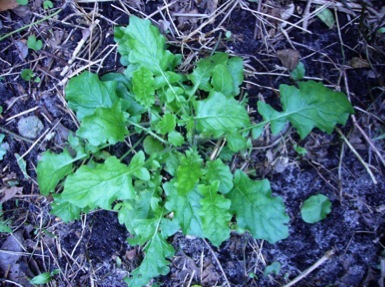
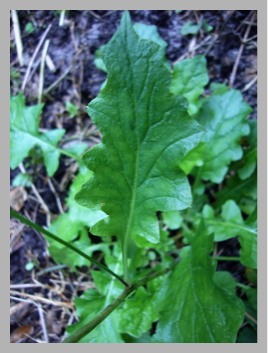
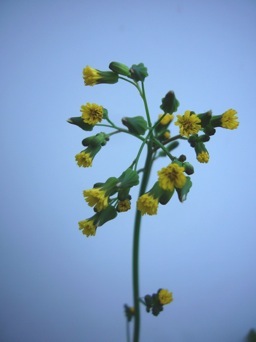
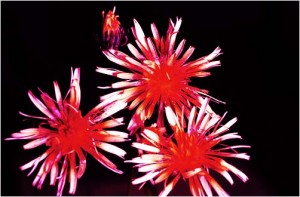
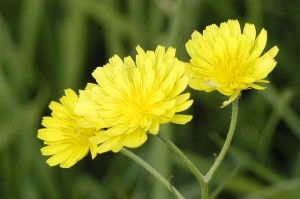
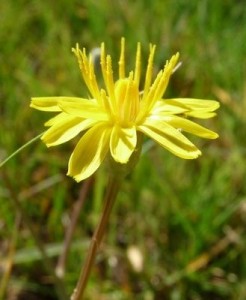
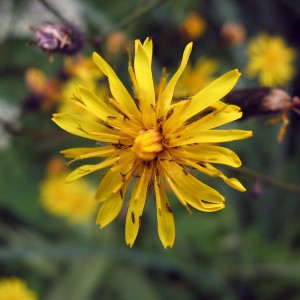
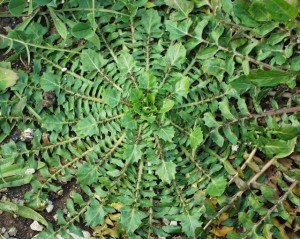

I’m so glad that I got your newsletter which led me to this! This plant is growing in my backyard and I’ve been nibbling on it and thinking about what it could be for like a week. I knew it was in asteraceae family and close to the dandelion, but that’s as far as I got lol. It’s very bitter to me. There is another plant just like it growing along with it with a bit of redness in the leaves, no flowers and a decent size root to nibble on. I don’t know if it’s this plant or a dandelion or something similar. I wonder what it’s medicinal properties are other than anticancer… something to do with the heart and yellow chakra…
Wow, and here I thought this was a variety of dandelion, Florida-style! Have been harvesting, eating and offering it with our wild edibles at the local downtown Lakeland Farmer’s market as Dandelion! So now, wondering if it’s health properties are similar enough to use the common name of “Florida Dandelion” and also wondering if true Dandelions even grow here at all? I live in Central Florida, used to live in South Florida and have not seen what I used to call Dandelions in Ohio growing here yet! Their anti-viral, anti-cancer properties would seem to put it on a level with Dandelions!
Interestingly there are no dandelion varities. Dandelions are reluctant to grow in Florida. They do but under protest ending up small, scraggly often red. I have never heard of using the Crepis root like one does the dandelion.
We’ve only been using the leaves, eating them pretty much raw, never trying the roots, not knowing if they would be edible (probably not toxic) or worth it. The leaves are only very mildly bitter. And the young leaves are even less.
I have these all over my yard. I also have ones like look a lot like these but with purple blossoms. Do you think they would be in the same family?
No. You are probably referring to Florida Tassel Flower (which can have lavender or red blossoms.) They are not edible.
Emilia sonchifolia?
I have been using the young leaves in green smoothies for over a year now. I actually mistook them for dandelion plants in the beginning, and by the time they grew bigger and I realised they weren’t dandelions, I already knew they were edible. Oh, well….no harm done 🙂
Does anyone know if these can be eaten by rabbits? Goats? Sheep? Chickens?… Am raising all of them and have this growing abundantly …
Thanks for any information.
Carol
My chickens love them! The great thing is when everything else is brown I can find these for my chickens. In the winter they can’t free-range because the hawks and eagles find them, so this gives them nutrients they lack in winter.
Can I juice creptis?
You can juice young leaves.
I have a similar plant in my yard, fits everything in the description, even the purple outside tinge. However, it does not have a taproot. It has a fibrous root system. Any ideas?
Sounds like Flea bane to me.
Thanks for the great information. I’ve spotted this Crepis Japonica all over my neighborhood! The reader who mentioned something similar that has a purple flower might be confusing the hawksbeard (c.japonica) with lyreleaf sage. Similar “crepe” / crinkled leaves, but with purple veins and a square stem. Any experience nibbling on Lyreleaf sage (or any recipes)?
First, don’t confuse the Florida Tasselflower (both pink and lavender) with the Lyre Leaf sage. As for the latter it has been subject of much discussion on this website and on the Green Deane Forum. There are opinions that it is edible, and there are opinions that it is not. I don’t know and probably never will. The last time I tried a related sage I was quite ill. So I am not in the mood to experiment.
We’ve been putting small amounts of lyre leaf sage in our lentil soup for some time now with no ill effects. The bulk of the greens in the soup (which we put in toward the end once the lentils are ready just like you would with spinach) are false Hawks beard and it is fantastic!
How can I determine with some certainty if I have hawksbeard or dandelion in my lawn? Thank you.
Get another pair of eyes to look at it.
‘Fancy doorstep’ does not seem an inappropriate name, since it grows unexpectedly in cracks and crevices and can make your steps look quite fancy.
That’s funny, because I just picked some of the False Hawksbeard that had leaves growing through our wooden back steps. I have a sample cooking right now. And I had noticed the purple around the leaf edges, too, and was relieved to know that verifies the ID for this nice wild veggie!! Thanks!
We have 11 species of crepis in Israel. I’ve just read onCrepis aspera that it is a poisonouse plant. can you comment?
Crepis aspera is Crepis setosa which is edible. However, it does have a texture issue and that often gets mangled into toxic.
Thank you for your news letter. I am so new to this that it will take me a while to catch on, the proper names are harder to remember but I will write them down and will eventually remember them. Your commentary is very interesting and enjoyable. I will be on the look out for Crepis Japonica or False Hawksbeard as I believe I see it everywhere.
Hi. I enjoyed your article. It should be noted that Youngia japonica is in fact a potentially noxious invasive plant. It was introduced into the US sometime after 1911. It occupies a variety of habitat spaces and will invade areas where it is not wanted. Unlike dandelion, which prefers sunny locations, we have seen this plant in full shade. It is fast growing and will dominate any open garden space in just a couple of years. It does not support pollinating insects and is only occasionally browsed by deer. I think it’s great to eat what grows in your yard and surrounds, but I would caution anyone on trying to introduce this plant into their garden space. In fact, one should remove flowers and dispose of them in the trash whenever possible as they will set seed even after being tossed into the compost pile. The seeds are wind dispersed and can end up some distance away.
Deane and Geoffrey:
Thank you so much for the detailed information!
I have two questions.
1) Is it definite that all Crepis is edible? I’m in Greene County, Georgia, which is slightly North-East Georgia. I’m pretty sure the Crepis in our red clay is Crepis Tectorum – narrow-leaved hawksbeard. I’d love to be sure it’s fine to eat.
2) Is Crepis Tectorum also invasive in North-East Georgia?
Hi Green Deane.
Thanks for your incredible resource centre.
Is Crepis Rubra edible?
Cheers
Sim from Australia
That’s an interesting question and the answer is I really don’t know. I have been told by a European herbalist that all Crepis are edible but I don’t know this species personally. I do note, however, that there has been some research on its edible seed oil.
Thanks for all this information about Crepis! C. japonica showed up in Austin, Texas about 25 years ago and is now frequently encountered in shady (or excessively watered) spots in urban areas. I will have to eat some on the way to work this morning.
Thought you might like to know that the authors of a Texas flora report that the genus Youngia honors “William Young, 1742-1785, German-born American botanist, nurseryman and gardener.” See:
Diggs, G. M., Jr., B. L. Lipscomb and R. J. O’Kennon. 1999. Shinners and Mahler’s illustrated flora of North-central Texas. Botanical Research Institute of Texas, Ft. Worth. 1626 pp.
Thank you! I thought so – ‘Youngia’ from some botanist named “Young”.
These plant-namers must be having fun, hehe.
Thanks for this info! You are right, hard to find anything on it other than the name.
This or a very similar weed has recently turned up in my yard. I am worried that it might be invasive. I think some seeds might have come in some bird seed. I live in SC just south of Charlotte, NC.
Hello Green Deane,
So I just read this article and im quite pleased with it, although recently I have been confused by a small flower gracing my lawn that looks very much like a Crepis species. However, it has long, grass like leaves (smooth and untapered) and produces small black seeds, in comparison to tufts of white that are often a marker of Crepis species. The flower is small, and grows on a slim stem, and emits a milky white sap when broken.
What plant is this? Is it edible? I enjoy making wildflower tea but I am hesitant to brew this flower as I do not know what it is and do not know if it is a Crepis species or not.
Please help. Thanks.
Milky sap is often an indicator of a spurge.
Thank you for the great info
Wow, its amazing how medicinally powerful this plant seems to be. I treated it as a common weed when I worked at an olive orchard south of San Antonio, TX. Billions of dollars each year could probably be made from marketing the “weeds” growing all around us as fresh produce and botanical extracts. Hopefully that great paradigm shift takes place soon.
Also, I must admit I take issue with how you are always trashing “Dead Latin”. To my knowledge, the Roman Catholic Church is a large-scale entity that has spoken Latin continuously since the Fall of Rome (I look to them as the ultimate authority on the language). I’d be willing to bet that the number of people in the world who use Latin in the fields of Law, Science, and Religion combine to equal a total that is many times greater than the number of people in the world who speak Greek. Over 15% of people in the world speak one of the languages spawned by Latin. As a Latinophile, a Latino, and as a descendant of the speakers of many “dead languages” from Mexico and south Texas, I see reconnecting with “dead languages” as a way of learning about one’s cultural heritage and about world history (for example, while Latin was “killed” by the Germanic invasion of Rome, Indigenous languages around the world were killed by Europeans during the Colonial Era).
Thanks for writing. The definition of a dead language is that it is not native to any population.
Can my African sulcata tortoise eat it
Thank you for the info. I have a whole yard full. I would love to send a Picture. I believe its the correct plant we moved to this location 3 years ago and have 3 acres. I did not want to mow and wanted to start native plants as we let it go back lots of natives came in. We also tried to add seeds and plants. I also want to have more medicinal plants added thanks alicia
You can send a picture to GreenDeane@gmail.com
Can you dry the roots for tea?
As a dandelion relative perhaps the root would be better roasted and ground.
I live in Georgia and believe I have a Crepis Japonica growing around me, the leaf shape, flower structure, sizing all match the photos. The leaves are a bit more matte – your photos look shinier, there is some purpling at the base of the stem, but I’m not seeing any purple tinging on the leaf. They are all younger specimens under 12″ height so maybe the purple comes later. Can you help me to verify the species so that I know if this an edible one? Gratitude!
I just found this article talking about using crepis neglecta in traditional italian cooking, unfortunately the whole article is limited access.
https://www.sciencedirect.com/science/article/abs/pii/S0367326X03001229
This document sites some species and their documented use. https://www.mdpi.com/2223-7747/11/4/519/pdf
Caution: Do not forage or garden for food within 5 ft of a termite-treated house or wall. Enjoy!
i can see lots of free music on the internet but most of them are pirated. .
NONE of the music attached to my site is pirated. It is all paid for. Also one listens to music rather than see music on the internet.
It’s a pity you don’t have a donate button! I’d definitely donate to this brilliant blog! I guess for now i’ll settle for book-marking and adding your RSS feed to my Google account. I look forward to fresh updates and will talk about this site with my Facebook group. Chat soon!
You lying spammer. I do have a donate button.